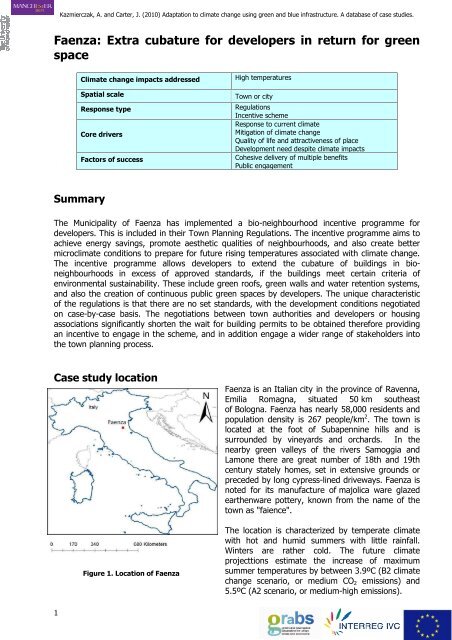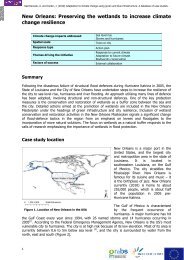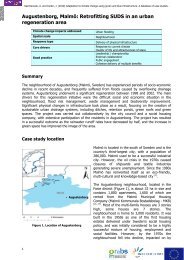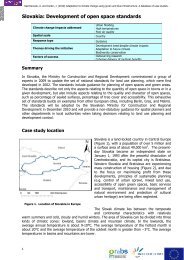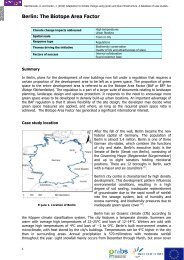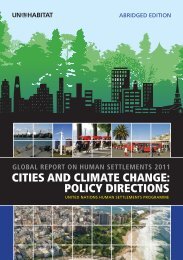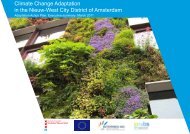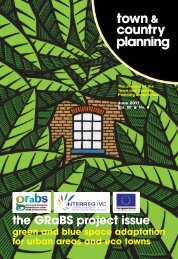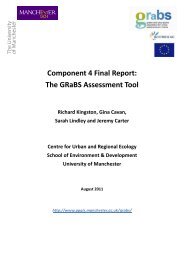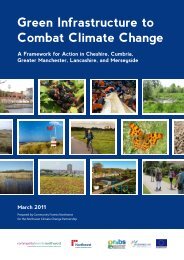Faenza: Extra cubature for developers in return for green ... - GRaBS
Faenza: Extra cubature for developers in return for green ... - GRaBS
Faenza: Extra cubature for developers in return for green ... - GRaBS
You also want an ePaper? Increase the reach of your titles
YUMPU automatically turns print PDFs into web optimized ePapers that Google loves.
Kazmierczak, A. and Carter, J. (2010) Adaptation to climate change us<strong>in</strong>g <strong>green</strong> and blue <strong>in</strong>frastructure. A database of case studies.<br />
<strong>Faenza</strong>: <strong>Extra</strong> <strong>cubature</strong> <strong>for</strong> <strong>developers</strong> <strong>in</strong> <strong>return</strong> <strong>for</strong> <strong>green</strong><br />
space<br />
Climate change impacts addressed<br />
Spatial scale<br />
Response type<br />
Core drivers<br />
Factors of success<br />
High temperatures<br />
Town or city<br />
Regulations<br />
Incentive scheme<br />
Response to current climate<br />
Mitigation of climate change<br />
Quality of life and attractiveness of place<br />
Development need despite climate impacts<br />
Cohesive delivery of multiple benefits<br />
Public engagement<br />
Summary<br />
The Municipality of <strong>Faenza</strong> has implemented a bio-neighbourhood <strong>in</strong>centive programme <strong>for</strong><br />
<strong>developers</strong>. This is <strong>in</strong>cluded <strong>in</strong> their Town Plann<strong>in</strong>g Regulations. The <strong>in</strong>centive programme aims to<br />
achieve energy sav<strong>in</strong>gs, promote aesthetic qualities of neighbourhoods, and also create better<br />
microclimate conditions to prepare <strong>for</strong> future ris<strong>in</strong>g temperatures associated with climate change.<br />
The <strong>in</strong>centive programme allows <strong>developers</strong> to extend the <strong>cubature</strong> of build<strong>in</strong>gs <strong>in</strong> bioneighbourhoods<br />
<strong>in</strong> excess of approved standards, if the build<strong>in</strong>gs meet certa<strong>in</strong> criteria of<br />
environmental susta<strong>in</strong>ability. These <strong>in</strong>clude <strong>green</strong> roofs, <strong>green</strong> walls and water retention systems,<br />
and also the creation of cont<strong>in</strong>uous public <strong>green</strong> spaces by <strong>developers</strong>. The unique characteristic<br />
of the regulations is that there are no set standards, with the development conditions negotiated<br />
on case-by-case basis. The negotiations between town authorities and <strong>developers</strong> or hous<strong>in</strong>g<br />
associations significantly shorten the wait <strong>for</strong> build<strong>in</strong>g permits to be obta<strong>in</strong>ed there<strong>for</strong>e provid<strong>in</strong>g<br />
an <strong>in</strong>centive to engage <strong>in</strong> the scheme, and <strong>in</strong> addition engage a wider range of stakeholders <strong>in</strong>to<br />
the town plann<strong>in</strong>g process.<br />
Case study location<br />
Figure 1. Location of <strong>Faenza</strong><br />
<strong>Faenza</strong> is an Italian city <strong>in</strong> the prov<strong>in</strong>ce of Ravenna,<br />
Emilia Romagna, situated 50 km southeast<br />
of Bologna. <strong>Faenza</strong> has nearly 58,000 residents and<br />
population density is 267 people/km 2 . The town is<br />
located at the foot of Subapenn<strong>in</strong>e hills and is<br />
surrounded by v<strong>in</strong>eyards and orchards. In the<br />
nearby <strong>green</strong> valleys of the rivers Samoggia and<br />
Lamone there are great number of 18th and 19th<br />
century stately homes, set <strong>in</strong> extensive grounds or<br />
preceded by long cypress-l<strong>in</strong>ed driveways. <strong>Faenza</strong> is<br />
noted <strong>for</strong> its manufacture of majolica ware glazed<br />
earthenware pottery, known from the name of the<br />
town as "faience".<br />
The location is characterized by temperate climate<br />
with hot and humid summers with little ra<strong>in</strong>fall.<br />
W<strong>in</strong>ters are rather cold. The future climate<br />
projecttions estimate the <strong>in</strong>crease of maximum<br />
summer temperatures by between 3.9ºC (B2 climate<br />
change scenario, or medium CO 2 emissions) and<br />
5.5ºC (A2 scenario, or medium-high emissions).<br />
1
Kazmierczak, A. and Carter, J. (2010) Adaptation to climate change us<strong>in</strong>g <strong>green</strong> and blue <strong>in</strong>frastructure. A database of case studies.<br />
Development of the <strong>in</strong>itiative<br />
Key aims<br />
The ma<strong>in</strong> aim of the bio-neighbourhood <strong>in</strong>centive programme <strong>in</strong>clude with<strong>in</strong> the Town Plann<strong>in</strong>g<br />
Regulations <strong>in</strong> <strong>Faenza</strong> is to <strong>in</strong>centivise <strong>developers</strong> (<strong>in</strong>clud<strong>in</strong>g hous<strong>in</strong>g associations set up by<br />
residents) to construct build<strong>in</strong>gs. The programme encourages these build<strong>in</strong>gs to be susta<strong>in</strong>able,<br />
utiliz<strong>in</strong>g appropriate materials and implement<strong>in</strong>g energy-sav<strong>in</strong>g and water-sav<strong>in</strong>g measures <strong>for</strong><br />
example. The aim is also to situate the build<strong>in</strong>gs <strong>in</strong> a way that allows a cont<strong>in</strong>uous area of <strong>green</strong><br />
space to be ma<strong>in</strong>ta<strong>in</strong>ed. There<strong>for</strong>e, the objectives of the <strong>in</strong>itiative range from issues <strong>in</strong>clud<strong>in</strong>g<br />
climate change adaptation, energy sav<strong>in</strong>g and improv<strong>in</strong>g urban quality.<br />
Themes driv<strong>in</strong>g the <strong>in</strong>itiatives<br />
Key issues taken <strong>in</strong>to account <strong>in</strong> the preparation of the 1999 Town Plann<strong>in</strong>g Regulations, which<br />
<strong>in</strong>clude the bio-neighbourhood <strong>in</strong>centive programme, are protection of the historic and natural<br />
features of the area, protection of archeological sites, protection and creation of open space,<br />
promot<strong>in</strong>g consistency of build<strong>in</strong>g types, and enhanc<strong>in</strong>g the well-be<strong>in</strong>g of the citizens.<br />
Inclusion of the rules on bio-neighbourhoods <strong>in</strong> the Town Plann<strong>in</strong>g Regulations was specifically<br />
driven by the need to create beautiful, livable, and low-energy neighborhoods to improve the<br />
quality of life of people liv<strong>in</strong>g <strong>in</strong> <strong>Faenza</strong>.<br />
The prior mechanisms that have set a framework <strong>for</strong> the bio-neighbourhoods programme <strong>in</strong>clude:<br />
• Engagement of <strong>Faenza</strong> residents <strong>in</strong> environmental issues l<strong>in</strong>ked to economic<br />
development.<br />
o "<strong>Faenza</strong> 2010 - The City We Want", an awareness rais<strong>in</strong>g campaign that started <strong>in</strong> 1998;<br />
o Award<strong>in</strong>g “Blue stickers” <strong>for</strong> cars and heat<strong>in</strong>g systems, which highlights the adherence to<br />
fuel- and energy-use standards;<br />
o “City Center by bike” transport <strong>in</strong>itiative.<br />
• Local Agenda 21: In 1999, the Municipality of <strong>Faenza</strong> jo<strong>in</strong>ed the national project “Agenda<br />
21” <strong>for</strong> urban areas: a pilot <strong>in</strong>itiative <strong>in</strong>volv<strong>in</strong>g some small-medium sized cities <strong>in</strong> Italy. This<br />
helped to promote development rules and practices based on the direct <strong>in</strong>volvement of<br />
<strong>developers</strong> and citizens <strong>in</strong> the urban design process.<br />
• Focus on <strong>green</strong> spaces: Dur<strong>in</strong>g the preparation of the 1999 Town Plann<strong>in</strong>g Regulations,<br />
<strong>Faenza</strong> approved a new “Municipal Rule of Green”, which emphasizes the role of <strong>green</strong> spaces<br />
<strong>in</strong> the improvement of urban quality.<br />
Details of the <strong>in</strong>itiative<br />
The Town Plann<strong>in</strong>g Regulations 1999 (Piano Regolatore Generale) <strong>in</strong>troduced an <strong>in</strong>centive scheme<br />
<strong>for</strong> <strong>developers</strong> to <strong>in</strong>corporate susta<strong>in</strong>able practices <strong>in</strong> build<strong>in</strong>g design. This approach was<br />
confirmed and extended by the Municipal Structural Plan <strong>in</strong> 2009. The <strong>in</strong>centive scheme utilizes<br />
the pr<strong>in</strong>ciple of “transfer of development rights” (perequazione urbanistica). At the design stage,<br />
the developer is allowed to extend the <strong>cubature</strong> of build<strong>in</strong>gs (both the number of floors and the<br />
size of the build<strong>in</strong>gs), or <strong>in</strong>clude more use types (residential, commercial, or <strong>in</strong>dustrial etc), if the<br />
development is characterized by certa<strong>in</strong> criteria relat<strong>in</strong>g to environmental susta<strong>in</strong>ability and<br />
aesthetic quality.<br />
2
Kazmierczak, A. and Carter, J. (2010) Adaptation to climate change us<strong>in</strong>g <strong>green</strong> and blue <strong>in</strong>frastructure. A database of case studies.<br />
To qualify <strong>for</strong> the <strong>in</strong>centive scheme, new developments need to meet the follow<strong>in</strong>g four ma<strong>in</strong><br />
criteria:<br />
1. Full utilization of space <strong>in</strong>side dwell<strong>in</strong>gs.<br />
2. Soundproof<strong>in</strong>g of build<strong>in</strong>gs and <strong>in</strong>door areas.<br />
3. Maximis<strong>in</strong>g ground permeability and water retention is encouraged utiliz<strong>in</strong>g measures such as<br />
water meter<strong>in</strong>g, use of technical devices reduc<strong>in</strong>g the waste of water and re-use of grey water.<br />
Systems of ra<strong>in</strong>water collection, filter<strong>in</strong>g and storage are also promoted.<br />
4. Creation of <strong>green</strong> areas and appropriate landscap<strong>in</strong>g of the external environment. This <strong>in</strong>cludes<br />
promot<strong>in</strong>g high quality design of courtyards and communal areas.<br />
In addition, <strong>in</strong> order <strong>for</strong> the developer to benefit from <strong>in</strong>creas<strong>in</strong>g the build<strong>in</strong>g’s size and variety of<br />
permitted uses, the <strong>green</strong> build<strong>in</strong>g criteria must be followed. These criteria are listed <strong>in</strong> the "Rules<br />
<strong>for</strong> the implementation of <strong>in</strong>centives to <strong>green</strong> build<strong>in</strong>g measures", which were developed by<br />
professional eng<strong>in</strong>eers of the Build<strong>in</strong>g Commission of the <strong>Faenza</strong> Municipality (Box 1). It is also<br />
significant that if the development <strong>in</strong>corporates exist<strong>in</strong>g build<strong>in</strong>gs, these must also be up-graded<br />
and reorganized to secure the susta<strong>in</strong>ability of the entire project.<br />
Box 1.The <strong>green</strong> build<strong>in</strong>g criteria<br />
• Spatial orientation: the build<strong>in</strong>gs should have large w<strong>in</strong>dows fac<strong>in</strong>g south-east and west<br />
• Promote use of natural and environmentally friendly materials<br />
• Avoid sources of pollution (<strong>in</strong>clud<strong>in</strong>g electromagnetic and acoustic pollution)<br />
• Promote natural ventilation<br />
• Use electrical systems which limit alteration of natural electromagnetic field<br />
• Use low-energy, low-emission and efficient heat<strong>in</strong>g systems<br />
• Use ra<strong>in</strong>water-recovery systems and use ra<strong>in</strong>water <strong>for</strong> water<strong>in</strong>g plants<br />
• Green spaces should be arranged <strong>in</strong> a way that provides shad<strong>in</strong>g and cool<strong>in</strong>g, as well as<br />
screen<strong>in</strong>g of w<strong>in</strong>d and noise. Appropriate tree species should be selected.<br />
• Take <strong>in</strong>to account local context, e.g. the environment, architecture and build<strong>in</strong>g types<br />
Furthermore, <strong>developers</strong> may create build<strong>in</strong>gs of a larger volume if they m<strong>in</strong>imize land<br />
consumption by concentrat<strong>in</strong>g the development <strong>in</strong> one part of the plot of land. This then leaves<br />
the rema<strong>in</strong><strong>in</strong>g land as open, public space, there<strong>for</strong>e improv<strong>in</strong>g urban quality and provid<strong>in</strong>g cool<strong>in</strong>g<br />
and shade. The required expansion of <strong>green</strong> space depends on the context of the development<br />
(Figure 2). In urban areas less <strong>green</strong> space is required <strong>for</strong> a development to qualify <strong>for</strong> the<br />
<strong>in</strong>centives, whilst <strong>in</strong> peri-urban areas the greater availability of land means that the developer is<br />
required to commit a proportionally larger part of the total plot to <strong>green</strong> space (Figure 3).<br />
Figure 2. Examples of <strong>green</strong>/permeable space landscap<strong>in</strong>g and build<strong>in</strong>gs <strong>in</strong> the bio-neighbourhoods<br />
3
Kazmierczak, A. and Carter, J. (2010) Adaptation to climate change us<strong>in</strong>g <strong>green</strong> and blue <strong>in</strong>frastructure. A database of case studies.<br />
Figure 3. Examples of bio-neighbourhoods <strong>in</strong> <strong>Faenza</strong>. Developers received permission to extend the size of<br />
a group of build<strong>in</strong>gs. In exchange, the build<strong>in</strong>gs had to be clustered <strong>in</strong> the north of the site <strong>in</strong> order to<br />
m<strong>in</strong>imize the use of land, and to create a large, cont<strong>in</strong>uous <strong>green</strong> space that can provide shad<strong>in</strong>g and<br />
cool<strong>in</strong>g.<br />
Implement<strong>in</strong>g the <strong>in</strong>itiative<br />
In order to receive the <strong>in</strong>centive, i.e. the permission to construct larger build<strong>in</strong>gs, the developer<br />
needs to provide the Municipality of <strong>Faenza</strong> with documentation describ<strong>in</strong>g the design of the<br />
project. This <strong>in</strong>cludes:<br />
1. Analysis of the immediate build<strong>in</strong>g development context and the surround<strong>in</strong>g environment<br />
2. Build<strong>in</strong>g plans and description of the <strong>in</strong>frastructure and build<strong>in</strong>g materials.<br />
The developer needs to present at least three different proposals of development of the<br />
site (such as one presented <strong>in</strong> Figure 4).<br />
This documentation is checked <strong>for</strong> compliance with the <strong>green</strong> build<strong>in</strong>g criteria list. There<strong>for</strong>e, the<br />
“transfer of development rights” is carried out on a case-by-case basis, and <strong>in</strong>volves considerable<br />
flexibility accord<strong>in</strong>g to the particular circumstances of the development. There are no set standards<br />
(such as traditional build<strong>in</strong>g standards), and the decision is made based on the per<strong>for</strong>mance of<br />
each particular build<strong>in</strong>g and the plot with<strong>in</strong> which it sits.<br />
4
Kazmierczak, A. and Carter, J. (2010) Adaptation to climate change us<strong>in</strong>g <strong>green</strong> and blue <strong>in</strong>frastructure. A database of case studies.<br />
Monitor<strong>in</strong>g and evaluation<br />
Municipal Adm<strong>in</strong>istration of <strong>Faenza</strong> has the power<br />
to assess, upon completion of the development<br />
project, whether the developer has actually<br />
followed the approved design of the plan, based<br />
on criteria <strong>in</strong>cluded <strong>in</strong> "Rules <strong>for</strong> the<br />
implementation of <strong>in</strong>centives to <strong>green</strong> build<strong>in</strong>g<br />
measures" (see Box 1).<br />
Stakeholder engagement<br />
The municipal adm<strong>in</strong>istration of <strong>Faenza</strong> was the<br />
lead<strong>in</strong>g actor <strong>in</strong> the development of the <strong>in</strong>itiative.<br />
The full support and political buy-<strong>in</strong> of the<br />
Municipality <strong>in</strong> implement<strong>in</strong>g the bioneighbourhood<br />
<strong>in</strong>centive scheme <strong>in</strong> the TOWN<br />
PLANNING REGULATIONS was an important<br />
factor <strong>in</strong> promot<strong>in</strong>g the susta<strong>in</strong>ability of<br />
development activities as a priority issue. Other<br />
ma<strong>in</strong> stakeholders are the <strong>developers</strong>, or groups<br />
of <strong>in</strong>dividual citizens, who want to construct a bioneighbourhood.<br />
The nature of the regulations<br />
enables stakeholders to be <strong>in</strong>volved <strong>in</strong><br />
negotiations on the design of build<strong>in</strong>gs and bioneighbourhoods,<br />
and consequently become<br />
Figure 4. Example of a development proposal<br />
engaged <strong>in</strong> the town plann<strong>in</strong>g process. The role of<br />
citizens is fundamental to the town plann<strong>in</strong>g process <strong>in</strong> <strong>Faenza</strong>, and their engagement is essential<br />
to secure new cont<strong>in</strong>uous <strong>green</strong> spaces and the improvement of overall environmental and<br />
aesthetic quality <strong>in</strong> the municipality<br />
Sources of fund<strong>in</strong>g<br />
The project was funded by Municipal and Regional Funds.<br />
Can it have an impact?<br />
Due to its <strong>in</strong>clusion <strong>in</strong> Town Plann<strong>in</strong>g Regulations, the bio-neighbourhood <strong>in</strong>itiative covers the<br />
whole territory of the Municipality of <strong>Faenza</strong>. As of 2010, two bio-neighbourhoods have been<br />
developed <strong>in</strong>clud<strong>in</strong>g a total of 500 apartments <strong>in</strong> 250 private property units. However, now that<br />
they are established, measures such as the <strong>green</strong> build<strong>in</strong>g criteria, requirements <strong>for</strong> permeable<br />
surfaces and ra<strong>in</strong>water recovery, and requirement <strong>for</strong> reduction of noise pollution, may be applied<br />
to all developments with<strong>in</strong> the municipality.<br />
The most important aspect of this <strong>in</strong>itiative is its <strong>in</strong>clusion <strong>in</strong> the Town Plann<strong>in</strong>g Regulations. The<br />
<strong>Faenza</strong> bio-neighbourhoods approach represents a true environmental plann<strong>in</strong>g <strong>in</strong>itiative, where<br />
the regulations go beyond a focus on traditional economic goals and are <strong>in</strong>stead based on urban<br />
susta<strong>in</strong>ability achieved through flexible rules and cooperation with citizens.<br />
The emergent <strong>green</strong> areas together <strong>for</strong>m a “<strong>green</strong> system”, which l<strong>in</strong>ks the town with the<br />
countryside, provid<strong>in</strong>g space <strong>for</strong> recreation and biodiversity functions (see also the case study of<br />
5
Kazmierczak, A. and Carter, J. (2010) Adaptation to climate change us<strong>in</strong>g <strong>green</strong> and blue <strong>in</strong>frastructure. A database of case studies.<br />
Mirandola, Appendix 1). Due to the improvement <strong>in</strong> town quality, the population of <strong>Faenza</strong> has<br />
grown by 6%.<br />
The lack of set standards encourages <strong>developers</strong> to search <strong>for</strong> and implement <strong>in</strong>novative solutions<br />
to the design of the build<strong>in</strong>gs and the surround<strong>in</strong>g area. Furthermore, the negotiations between<br />
the <strong>developers</strong> and the municipality based around flexible rules are less time consum<strong>in</strong>g than the<br />
process of check<strong>in</strong>g adherence to rigid build<strong>in</strong>g standards. Reduced time of obta<strong>in</strong><strong>in</strong>g build<strong>in</strong>g<br />
permits (thanks to the participative character of town plann<strong>in</strong>g process) encourages <strong>developers</strong> to<br />
<strong>in</strong>vest <strong>in</strong> <strong>Faenza</strong>. Similar <strong>in</strong>centive systems are now be<strong>in</strong>g used <strong>in</strong> other municipalities <strong>in</strong> the<br />
region (see short case study of Mirandola).<br />
The Town Plann<strong>in</strong>g Regulations <strong>in</strong> <strong>Faenza</strong> have received a wide recognition and a number of<br />
awards, both nationally and <strong>in</strong>ternationally:<br />
• First prize <strong>in</strong> National ENEA (National Agency <strong>for</strong> New Technologies, Energy and Environment)<br />
1999 scheme <strong>for</strong> the <strong>in</strong>novative approach of their Town Plann<strong>in</strong>g Regulations.<br />
• <strong>Faenza</strong> was among six urban plans that the UK Royal Town Plann<strong>in</strong>g Institute chose to present<br />
at the Johannesburg World Summit on Susta<strong>in</strong>able Development (2002) as exemplary<br />
examples.<br />
• The Municipality of <strong>Faenza</strong> (RA) received a European Prize <strong>for</strong> Urban and Regional Plann<strong>in</strong>g<br />
(Challenges 2009) <strong>for</strong> environmental protection, the consideration and promotion of energy<br />
and environmental susta<strong>in</strong>ability, the application of bio-climatic techniques, the adoption of<br />
flexible procedures, and the <strong>in</strong>novative <strong>in</strong>centive system.<br />
Key messages<br />
• The use of flexible rules <strong>in</strong> Town Plann<strong>in</strong>g Regulations to promote susta<strong>in</strong>able development<br />
can be as efficient as rigid standards;<br />
• The participative character of the process means that the details of the development are<br />
negotiated, what can save time and resources <strong>for</strong> both the developer and the municipality;<br />
• The use of an <strong>in</strong>novative approach <strong>in</strong> Town Plann<strong>in</strong>g Regulations means that the municipality<br />
of <strong>Faenza</strong> is now recognized <strong>in</strong> Italy and <strong>in</strong> Europe <strong>for</strong> high quality plann<strong>in</strong>g and the example is<br />
followed by other municipalities <strong>in</strong> the region;<br />
• Agreements with <strong>in</strong>dividual <strong>developers</strong> can lead to the creation of cont<strong>in</strong>uous <strong>green</strong> spaces <strong>in</strong><br />
areas where land is privately owned;<br />
• While the Town Plann<strong>in</strong>g Regulations were driven by energy efficiency, aesthetic qualities and<br />
quality of life, they are likely to br<strong>in</strong>g climate change adaptation benefits <strong>in</strong> terms of reduc<strong>in</strong>g<br />
the impact of high temperatures and lessen<strong>in</strong>g flood risk.<br />
Resources<br />
http://www.edilia2000.it/633d3526613d3226703d333837312c6e6577732631313d3126353d34/più-sostenibilità-prgfaenza.html<br />
http://www.urbanisti.it/old/consiglioeuropeo-n/Articolo_Premio_IT.htm<br />
http://g5.ambra.unibo.it/portale/documents/Comunicazione/home_comunicazione.php?id_page=204<br />
http://g5.ambra.unibo.it/portale/documents/Comunicazione/home_comunicazione.php?id_page=504<br />
http://www.planum.net/4bie/ma<strong>in</strong>/m-4bie-faenza.htm<br />
http://www.comunef<strong>in</strong>ale.net/download/regolamento_verde.pdf<br />
Acknowledgements<br />
In<strong>for</strong>mation <strong>for</strong> this case study has been collected and translated from Italian to English by two<br />
researchers from the University of Catania visit<strong>in</strong>g at the University of Manchester: Irene Iannì and<br />
Maria Grazia Cuvato.<br />
6


